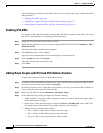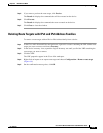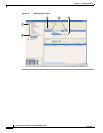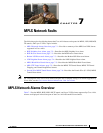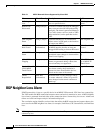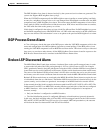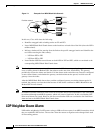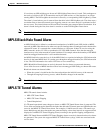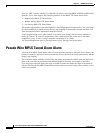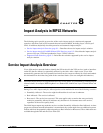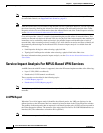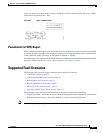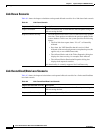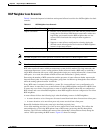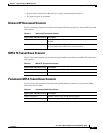
7-6
Cisco Active Network Abstraction 3.6.6 MPLS User Guide
OL-19192-01
Chapter 7 MPLS Network Faults
Pseudo Wire MPLS Tunnel Down Alarm
For Cisco CRS-1 routers running Cisco IOS XR 3.6 software and using PBTS in MPLS or MPLS VPN
networks, Cisco ANA supports the following ubalarms for the MPLE TE Tunnel Down alarm:
• High Priority MPLS TE Tunnel Down
• Medium Priority MPLS TE Tunnel Down
• Low Priority MPLS TE Tunnel Down
The specific subalarm that is generated depends on the EXP bit specified for the traffic. Cisco ANA maps
the specified EXP bit to tunnel priority and uses that mapping to generate the resultant subalarm. The
alarm description includes information about the EXP bit.
Tunnel reoptimization occurs when a tunnel is up and its route changes but the tunnel continues to
remain up. When a TE tunnel is reoptimized to take a different path, the system parses the tunnel
reoptimized syslog, if such a syslog is available, and displays it as a ticket.
The Tunnel Reoptimized alarm is generated from a syslog message sent by the router.
Pseudo Wire MPLS Tunnel Down Alarm
A Pseudo Wire MPLS Tunnel Down alarm is issued when the pseudowire link goes down, namely, the
pseudowire tunnel is reported as down from both the devices (based on the status of the tunnel), and the
tunnel is not flapping.
The correlation engine identifies various faults that affect the pseudowire tunnel status and reports on
them as the root cause for the Pseudo Wire MPLS Tunnel Down alarm, for example, Link Down.
Cisco ANA traces the LSE path to the edge of the PWE3 tunnel and marks the edges of the tunnel as
affected. The Pseudo Wire MPLS Tunnel Down alarm is detected actively by the system, namely, service
alarms are generated.



